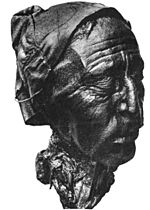Tollund Man facts for kids
The Tollund Man was a man who lived a very long time ago, around 400 BC. This was during a period called the Pre-Roman Iron Age in Scandinavia. His body was found in 1950 in a bog near Silkeborg in Denmark.
Bogs are special wetlands that can naturally preserve bodies. This turns them into what we call "bog bodies" or "mummies." The Tollund Man's body was so well preserved that people first thought he was a recent crime victim! Experts believe he was likely offered as a sacrifice to ancient gods.
Contents
Finding the Tollund Man
On May 8, 1950, two brothers named Viggo and Emil Hojgaard were cutting peat in the Bjældskovdal bog. Peat is a type of soil made from decayed plants. As they worked, they discovered a body buried deep in the peat.
The Tollund Man was lying about 60 meters from solid ground. He was buried under 2.3 meters of peat. His body was curled up in a position like a baby in a womb.
He wore a pointed cap made of sheepskin and wool. It was tied under his chin with a leather strap. He also had a smooth leather belt around his waist. Around his neck was a noose made of braided animal hide. Other than these items, his body was bare.
His hair was cut very short, almost hidden by his cap. He had short stubble on his chin and upper lip. This suggests he usually shaved, but not on the day he died. Experts believe the Tollund Man was about 40 years old when he died.
Studying the Tollund Man
Scientists used a method called Radiocarbon dating to find out when the Tollund Man lived. They discovered he died around 405–380 BC. His soft body parts, like skin and organs, were very well preserved.
This amazing preservation happened because of the special conditions in the bog. The peat in the bog is very acidic, like vinegar. There was also very little oxygen under the surface, and the climate was cold. These conditions stopped his body from decaying. A plant called Sphagnum moss, found in bogs, helps create these acidic conditions.
Scientists also studied the element strontium in his bones and hair. This helped them learn where he might have traveled. The results showed he likely spent his last year in Denmark. He might have moved at least 20 miles in his last six months.
X-rays and examinations showed that his head was not damaged. His heart, lungs, and liver were also in good condition. The Silkeborg Museum estimated his height was about 1.61 meters (about 5 feet 3 inches). This was a bit short, even for people of his time. His body likely shrunk a little in the bog.
In 1950, doctors concluded that the Tollund Man died by hanging. The rope left clear marks on his neck. In 2002, more forensic tests supported this idea.
Scientists also examined his stomach and intestines. They found his last meal was a porridge or gruel. It was made from grains and seeds, both grown and wild. About 40 different kinds of seeds were found. The porridge mostly had barley, flax, false flax, and knotgrass. He had eaten this meal 12 to 24 hours before he died. This type of porridge was common back then. Since no meat or fresh fruit was found, it suggests he ate this meal in winter or early spring.
His feet and right thumb were also well preserved. In 1976, the Danish police analyzed his thumbprint. This makes the Tollund Man's thumbprint one of the oldest ever recorded!
Where to See the Tollund Man
Today, the Tollund Man is on display at the Silkeborg Museum in Denmark. However, only his head is original. When he was found in the 1950s, scientists did not have good ways to preserve an entire body. So, they decided to cut off his head to save it. The rest of his body dried out and the tissues disappeared.
In 1987, the Silkeborg Museum rebuilt his body using his bones as a base. Now, his original head is attached to a replica (a copy) of his body for visitors to see.
Other Bog Bodies
More than 500 bog bodies and skeletons from the Iron Age have been found in Denmark. Some other famous ones from Jutland include the Borremose bodies, Huldremose Woman, and Grauballe Man. About 30 of these bog bodies are kept or displayed in Danish museums for ongoing research.
See also
 In Spanish: Hombre de Tollund para niños
In Spanish: Hombre de Tollund para niños




